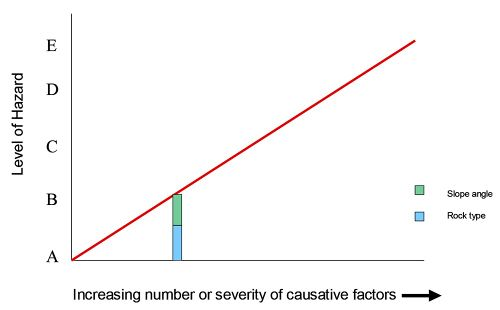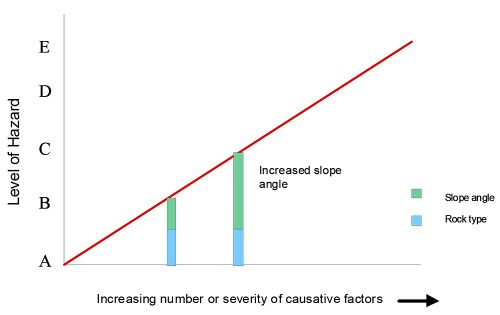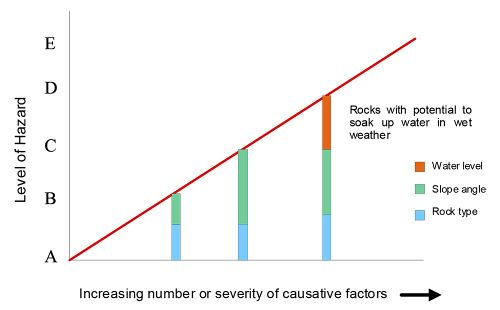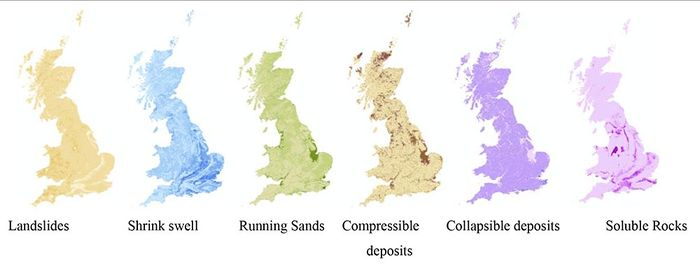OR/14/012 Technical information: Difference between revisions
m 1 revision imported |
|||
(No difference)
| |||
Latest revision as of 08:51, 5 April 2016
| Lee, K A, and Diaz Doce, D. 2014. User guide for the British Geological Survey GeoSure dataset. British Geological Survey Internal Report, OR/14/012. |
Definitions
Hazard: A potentially damaging event or phenomenon.
Risk: The impact of the hazard on people, property or capital.
For example, a shrinkable clay could be perceived as a hazard, but the likelihood of it causing structural damage would be the risk.
A high hazard does not necessarily translate to a high risk. For example, if a particular location has a relatively high ground stability hazard, but the properties that are built there have taken this into account, and are designed to withstand the hazard, they will not have a comparable level of risk. This is because the likelihood of the hazard causing any loss has been reduced due to the design of the property.
GeoSure does not identify the cost of a hazard being realised, and therefore does not consider risk. GeoSure only examines the conditions that leave an area exposed to a hazard.
Scale
The GeoSure natural ground stability dataset is produced for use at 1:50 000 scale providing 50 m ground resolution.
Field descriptions
| Field name | Field description |
| CLASS | Classification of hazard on a scale of A–E |
| LEGEND | Description of the hazard |
| VERSION | Dataset name and version number |
Full class descriptions as they appear in the dataset are shown in Appendix 1 - GeoSure legends.
Creation of the dataset
Each natural ground stability hazard GIS layer is rated on an A–E classification (representing increasing hazard). The soluble rocks layer has a NULL category for areas where rocks or soils that contribute to these specific hazards are not thought to occur. For each layer, a brief description of the hazard is provided for each hazard level. These descriptions are shown in Appendix 1 - GeoSure legends.
To produce the GeoSure natural ground stability data layers, the assessment of hazard is made by:
- identifying the factors that are involved in creating the hazard
- assessing which are thought to be present at each location
- assessing how significant they are thought to be at each location
The factors are then combined to estimate the level of hazard. The level of potential hazard does not mean that a damaging event is going to happen but is an indication of how many causative factors may be present and how severe they are thought to be. For example, in the case of the potential for slope instability, the factors are:-
- The type of rock forming the slope
- The gradient of the slope
- The water level in the slope
As an illustration, consider a rock type, clay, which is known to be associated with landslides in some parts of Britain. Figure 1 illustrates the hazard rating given if this rock type was present on a slope with a very gentle gradient. The resultant hazard rating remains very low (B).

Figure 2 illustrates the scenario if the gradient of the slope was steeper and the potential for slope instability is greater. The contribution to the hazard rating by slope gradient is increased, leading to a higher hazard rating.

Figure 3 illustrates a further scenario, where, in another area, the same clay rocks and the same gradient as shown in Figure 2 are present, but, the presence of water makes the hazard potential greater, raising the hazard potential to a level D. This may occur, for example, in locations where the rocks present are also know to be susceptible to soaking up water during a wet winter or severe rainfall event (something which is known to weaken rocks).

If an area is classed as level D for slope instability hazard, this means it is a state such that a relatively small change in conditions might cause a ground movement to take place. Any of the factors could become more significant. The material of the slope may weaken due to weathering, the slope may be steepened by undercutting or more water may soak into the rocks. It is also possible that another factor might add to the three that are present. In some countries an earthquake might add the final factor leading to failure. In Britain, it is more likely that one of the existing factors will increase such as an increase in the amount of water present due to continued wet weather, or even a leaking drain (Figure 4).

Thus the hazard assessment method can be used to indicate how vulnerable areas are to experiencing hazard events and of how frequently these hazard events might be expected to occur.
Use of this data can help manage land to best advantage, safely and with the lower likelihood of financial loss.
Dataset history
BGS is continually surveying and resurveying areas of Britain, improving and updating the geological maps. These updates are made to DiGMapGB-50 regularly. As GeoSure is based upon the most up to date information available, each new version of DiGMapGB-50 prompts a new version of GeoSure. BGS is committed to improving GeoSure as more information becomes available. Additional enhancements are made to the datasets for each new version. Below is an outline of the data history of GeoSure.
Version 1 (released 2004): Derived from DiGMapGB-50 version 1.
Version 2 (released 2005): Derived from DiGMapGB-50 version 2, incorporating superficial thickness data and enhancements to understanding the behaviour of some glacial deposits.
Version 3 (released 2006): Derived from DiGMapGB-50 version 3, incorporating enhancements in quaternary mapping of localised areas in England and Wales, and large areas of Scotland. Each data layer is also rectified to align with British National Grid origin. Date of release changed to January.
Version 4 (released 2008): New 1:50 000 and higher geological mapping in 21 areas. Improvement of the NEXTMap DTM in areas of tree cover throughout GB. Higher resolution Superficial thickness model used throughout GB.
Version 5 (Released 2009): New 1:50 000 geological mapping in 14 areas. Fully revised Dissolution methodology. Geologist interpreted superficial thickness model included.
Version 6 (Released 2011): New 1:50 000 geological mapping in 18 areas. Fully revised and geologist interpreted collapsible ground methodology. Updated Superficial Thickness Model version 5 included. Methodologies for all layers now scripted and vector data is utilised all the way through the creation process.
Version 7 (released 2014): New 1:50 000 geological mapping in 20 areas plus minor changes across England, Scotland and Wales. New information incorporated into the shrink-swell layer as a result of research and modelling of lithological variations in the London Clay. Partially revised methodology for the Slope Stability (Landslides) layer incorporating additional information from the DiGMapGB-50 mass movement layer.
Coverage
Data is provided to identify each of the six natural geohazards in Great Britain. In addition, the Isle of Man is covered for all hazards apart from Landslides as the Isle of Man is not covered by the digital terrain model that is used. Each data layer is shown in Figure 5 and the scale of coverage is provided in Appendix 2 - Mapping scales.

Data format
The GeoSure natural ground stability dataset has been created as vector polygons and are available in a range of GIS formats, including ArcGIS (.shp), ArcInfo Coverages and MapInfo (.tab). More specialised formats may be available but may incur additional processing costs.
Limitations
- GeoSure has been developed at 1:50 000 scale and must not be used at larger scales, and all spatial searches against the data should be done with a minimum 50 m buffer.
- GeoSure data are created as vector polygons and are available in a range of GIS formats, including ArcGIS (.shp), ArcInfo Coverages and MapInfo (.tab). More specialised formats may be available but may incur additional processing costs.
- GeoSure is concerned with potential ground stability related to NATURAL geological conditions only. GeoSure does NOT cover any man-made hazards, such as contaminated land or mining. The only exception to this is the Compressible Ground hazard layer, which does consider man-made ground e.g., landfill.
- GeoSure is based on, and limited to, an interpretation of the records in the possession of The British Geological Survey at the time the data set was created.
- An indication of natural ground instability does not necessarily mean that a location will be affected by ground movement or subsidence. Such an assessment can only be made by inspection of the area by a qualified professional.
- The words provided in Appendix 1 - GeoSure legends are designed to provide a general indication of the meaning of the various GeoSure hazards levels. If the data is to be used for advising specific sectors of end users in detail, e.g. home-buying, property insurance, site development and construction, then the BGS can provide additional end user guides and additional attribution details for the data. To find more about this, please contact our Business Solutions department through the Central Enquiries Desk using the contact details at the start of this document.